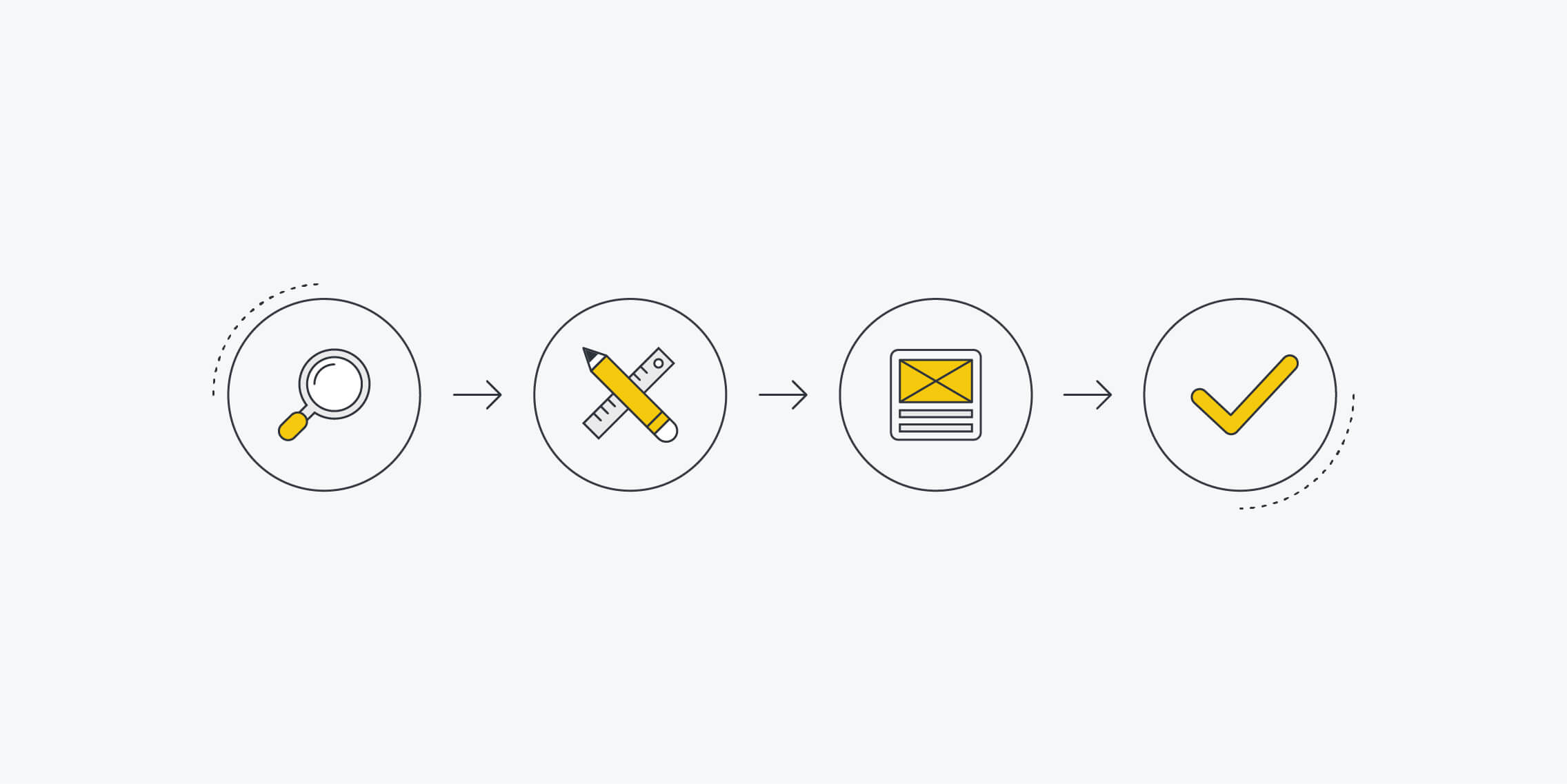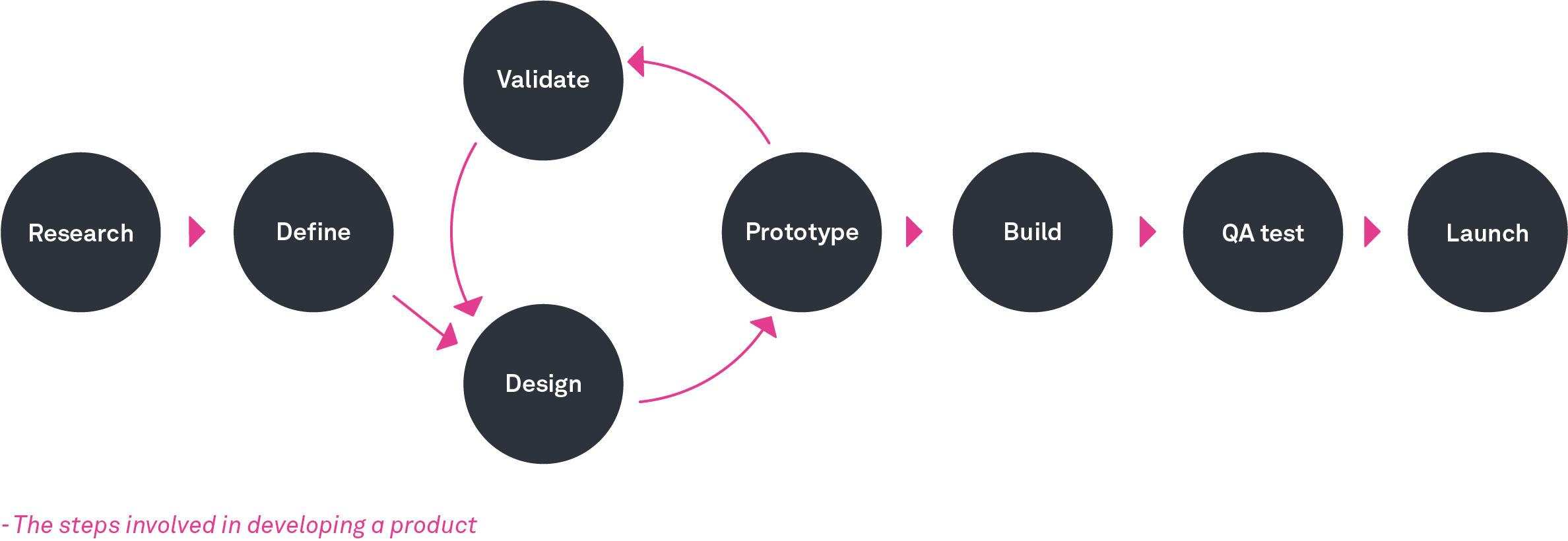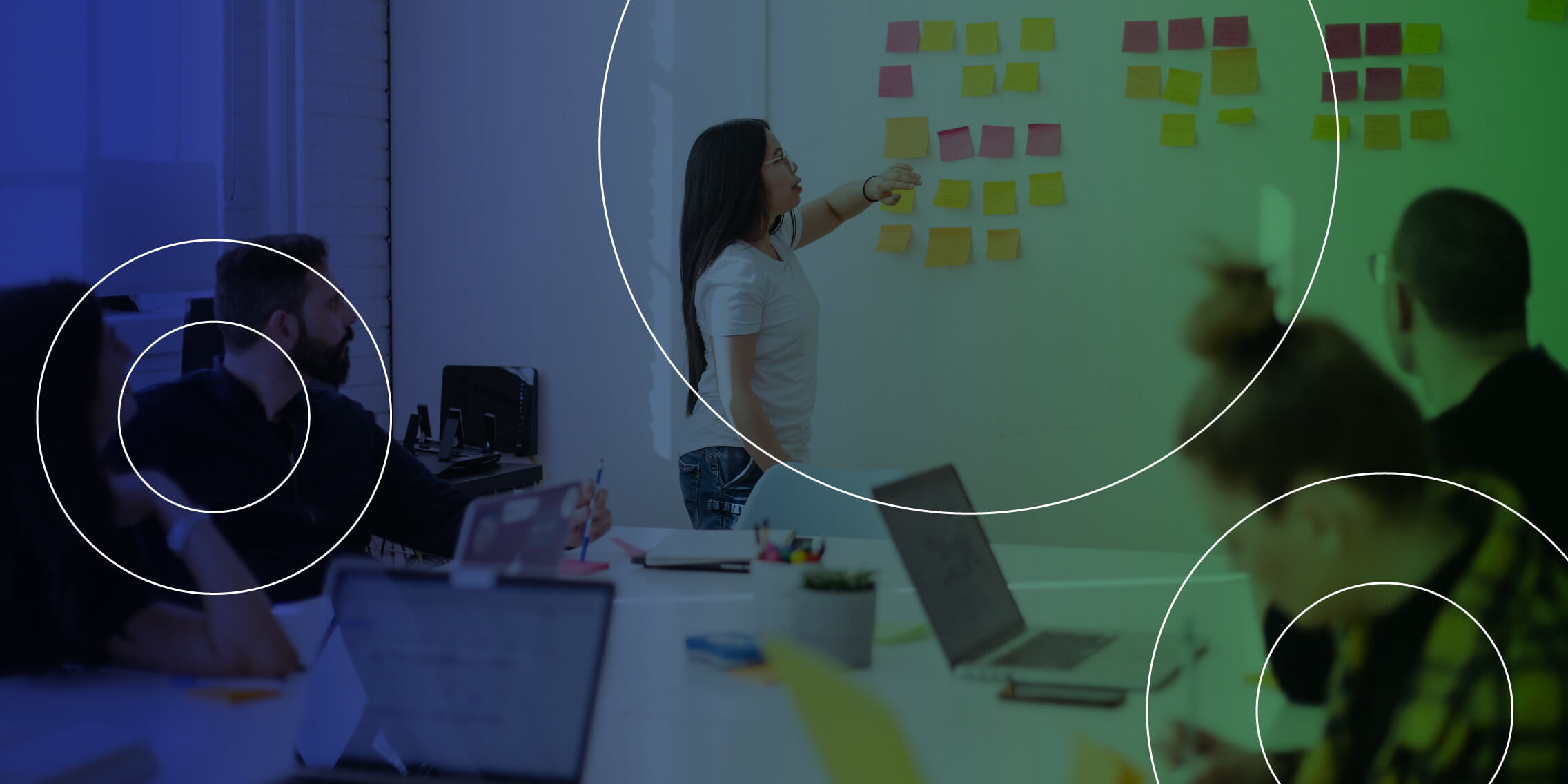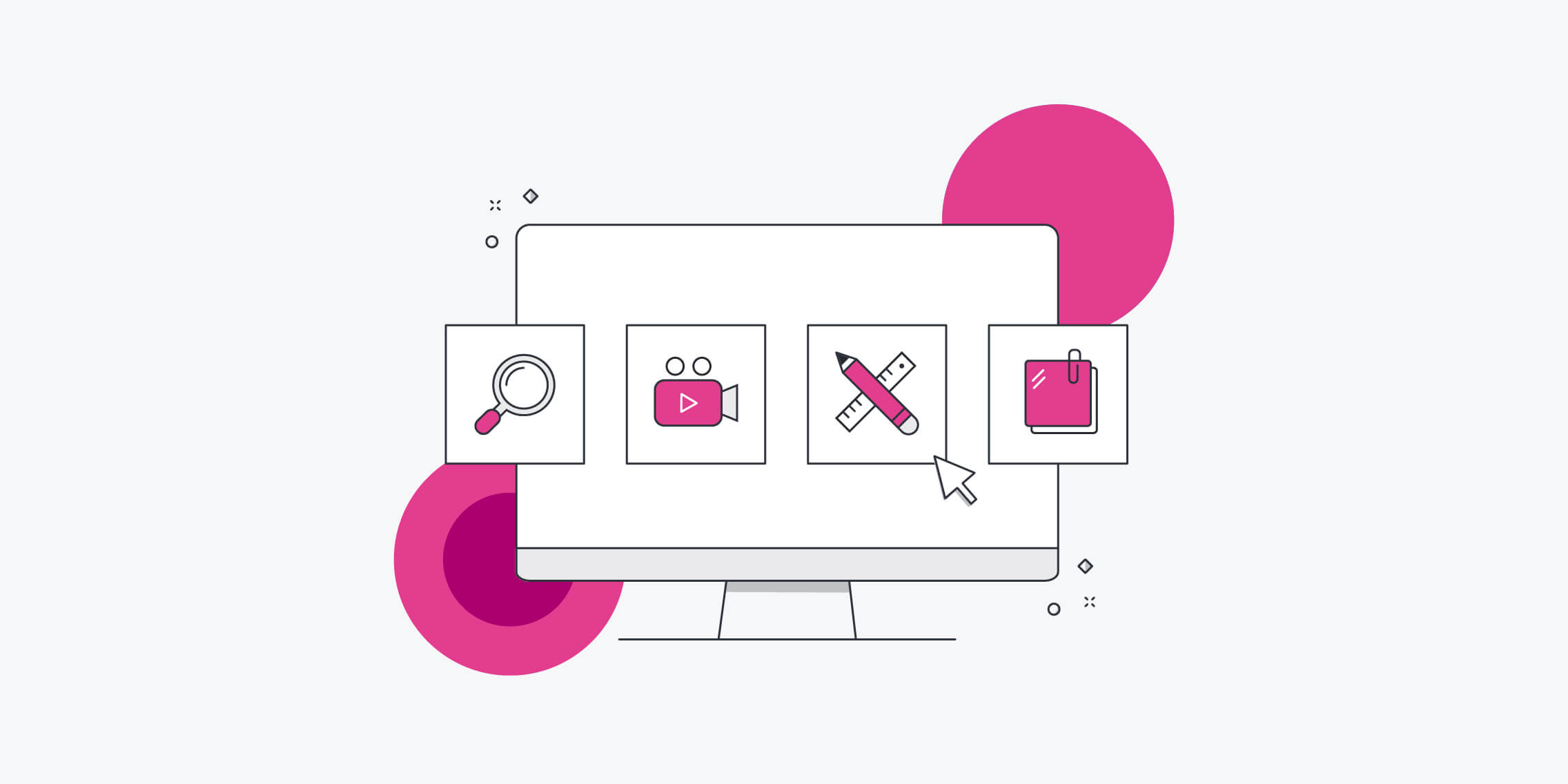Understanding the UX design process is crucial for every role within UX.
To make great products, you need to follow the process closely – and there are different skills and tools required at each stage.
Curious to know more? In this piece, we’ll explore:
- What is the UX design process?
- What happens at each stage of the UX design process?
- How do different roles fit into the UX design process?
- What happens if I skip steps in the UX design process?
Let’s begin with an overview of what the UX design process is.
What is the UX design process?
‘UX’ stands for user experience and UX design is all about creating experiences (in the form of products and services) that solve problems for users. The UX design process is the structure we use to help identify and solve those problems.
For example, a common problem among your target audience might be that they struggle to stay on top of their monthly budget. You’d go through the UX design process to understand what kind of solution they might need in order to address the problem, to come up with ideas, design and test them, and eventually, build them into a live product (e.g. a smart budgeting app).
The UX process ensures we’re building products that people actually want to use. It gives the whole team a clear vision for the product and it ensures that the end users’ needs are being considered every step of the way.
So: What does the UX design process look like and what are the steps involved?
The following steps can take you all the way from an idea to a product launch:
- Research
- Define the user problem
- Design
- Prototype
- Validate
- Build
- QA Test
- Launch
Note that these steps don’t always take place in a strictly linear fashion. You might get to the prototyping stage, only to find that your initial idea is flawed or that it doesn’t actually solve the user problem.
With those insights, you might go back to the design stage to come up with a new solution, or even to the problem definition stage to assess whether you’re focusing on the most important user challenge.
The steps below can take you all the way from an idea to a product launch:
The UX process is everything that happens before a design is sent to developers to be built. It makes up the first few steps from research to prototyping.
A simplified version of the UX design process might look like this:
- Research
- Design
- Prototype
- Validate
That’s the UX design process in a nutshell. Now let’s take a closer look at what happens at each stage.
What happens at each stage of the UX design process?
Research and problem definition
The UX design process begins with user research. This involves speaking to or observing real users (or people who represent your target users) to figure out what problems they have and what they desire and require from a solution.
User research can be qualitative (which involves learning about users’ thoughts, feelings and opinions) or quantitative (which looks at measurable data such as how many times a user clicks on a certain button or how long it takes them to complete a particular task).
Some common UX research methods include user interviews, surveys, A/B tests, card sorting, first-click tests and eye-tracking. The research stage can also involve researching competitors to see what’s already on the market.
Once you’ve conducted user research, the next step is to analyse your findings and synthesise the results into meaningful, actionable insights. You’ll then present your UX research findings to key stakeholders. Here, you’ll find a guide on how to write a UX research report and share your findings.
During the research phase, UX designers use a variety of different tools depending on their chosen research methods. You can learn about the most popular UX research tools and how they’re used here.
Based on the findings of your UX research, you’ll then identify the most pressing user problem that needs to be solved. This is known as the problem definition stage and it usually involves crafting a problem statement — a short summary of the problem you’re going to design a solution for.
To help you come up with ideas for how to solve your user problem, you might turn your problem statement into a series of “How Might We?” questions. The “How Might We?” format reframes the problem in a way that invites solutions.
For example: “How might we make it easier for 25-35 year olds to manage their monthly budget?” or “How might we improve the budgeting feature in our app to make it easier for 25-35 year olds to see their monthly expenditure?”
Once you have a clear grasp on the problem you’re trying to solve, and the people you’re solving it for, you can move on to the next stage in the UX design process.
Design
The design stage is where you come up with potential solutions to your user problem. Here you choose one solution that is most feasible and most likely to meet the users’ needs and then you start to bring it to life by designing it.
Let’s imagine that the solution you’ve decided to pursue is a budgeting feature that you’ll add to an existing app. The design phase might include sketching out initial ideas for how the new feature will work, considering things like what functionality it will provide, where it’ll sit in the app and how the user will get to it.
With the initial ideas sketched out, you’ll then consider the information architecture of the new feature (i.e. how it will be structured and organised in terms of content and information) and map out user flows. A user flow is a chart or diagram which depicts the path a user will take to complete a certain task. So, for your new feature, you might create user flows to determine how the user will complete tasks such as assigning a category to an outgoing transaction (e.g. household, travel, entertainment, fitness, groceries and so on) or accessing the monthly breakdown of their spending.
From there, you’ll create wireframes to further firm up the design of your new feature. Wireframes can be created by hand (very low-fidelity wireframes) or digitally using a variety of wireframing tools.
Prototype
Having laid out the blueprint for your new product or feature, the next step is to fine-tune the details of the design and create a more lifelike model of how the product will look and function. This is done during the prototyping phase.
A prototype is a simulation that shows how users will interact with the finished product. Prototypes can be interactive and clickable, allowing stakeholders (and sample users) to interact with them as if they’re a live product.
The purpose of prototyping is to give you something to test before you spend time and money developing your design into a living and breathing product. It enables you to make sure that the solution you’ve come up with is user-friendly and accessible. It also ensures that users are able to interact with it in the way you originally intended.
Learn more in this complete guide to prototyping and discover the prototyping tools that UX designers use at this stage in the UX design process.
Validate
The validation stage is all about testing your designs to make sure they’re effectively solving the user problem and that they’re a joy to interact with.
This step in the process requires UX testing (or usability testing) on real or representative users. It’s absolutely critical as it gives you the chance to identify problems with your designs and fix them before you go to development, ultimately saving you time, money and disgruntled users.
Essentially, UX testing allows you to validate or invalidate your designs, determining whether you move forward to the development stage or return to the design stage to make adjustments.
As you can see, each step in the UX design process is geared towards ensuring that the products you create are beneficial to your end users and built with their needs in mind. That’s the key to good UX and you can’t create successful products otherwise.
How do different roles fit into the UX design process?
UX is a team sport. Different people are required at different stages. It’s fluid. It’s collaborative. And it changes to suit the needs of the business.
Here’s where different UX roles fit into the process:
- Researchers work on the Research and Validate stages
- Content experts ensure the copy and design are aligned at each stage
- UX designers lead the Design and Validate stages but play an important role throughout
- UI designers will work with UX designers on the Prototype and Validate stages – you can learn more about how UX and UI designers work together here
- Developers come in at the Validate stage, where they turn prototypes into live products
Specialists like researchers and content experts are commonly employed where UX is integral to the operation. This could be anywhere from HubSpot to NHS Digital.
In smaller companies with limited resources, it’s normal to have generalists that work across the process.
If you’d like to learn more about different roles within the UX team, check out this list of 11 UX job titles.
What happens if I skip steps in the UX design process?
As UX mentor James O’Brien explains:
Each step in the lifecycle builds on the previous one. Skipping steps will lead to less than ideal outcomes.
Cutting corners takes you away from the user. So why do UX professionals skip steps in the first place?
Business people sometimes want to prioritise business needs over users. Your boss may argue that user research is “too expensive”. This isn’t true.
James warns that, when working in UX, you may have a boss or colleague that wants to do a “quick” version of UX:
They want to skip research and just go to what they understand as design. Have a conversation that begins with ‘here’s what I need to do in order to get it right’. See if you can get their buy-in.
If you skip certain steps in the UX design process, you risk missing out on the true value that good UX brings. The business value of UX design is well-documented; you’ve probably read the much-cited statistic that, on average, every $1 invested in UX brings a return of $100.
The value of UX (and the value of following the UX design process) boils down to creating products and services that people actually need and want to use. That translates into customer loyalty, higher conversion rates, increased sales and revenue and a competitive edge in your market.
As a general rule, follow the process as closely as possible. It’s what separates excellent products from average ones.
Want to learn more about the UX process and how UX designers work? See what a day in the life of a UX designer looks like.






![What does a UX designer do? [2025 Update] 6 what does a ux designer do blog header image](https://www.uxdesigninstitute.com/blog/wp-content/uploads/2020/09/10_What-does-a-UX-designer-do_Image.png)